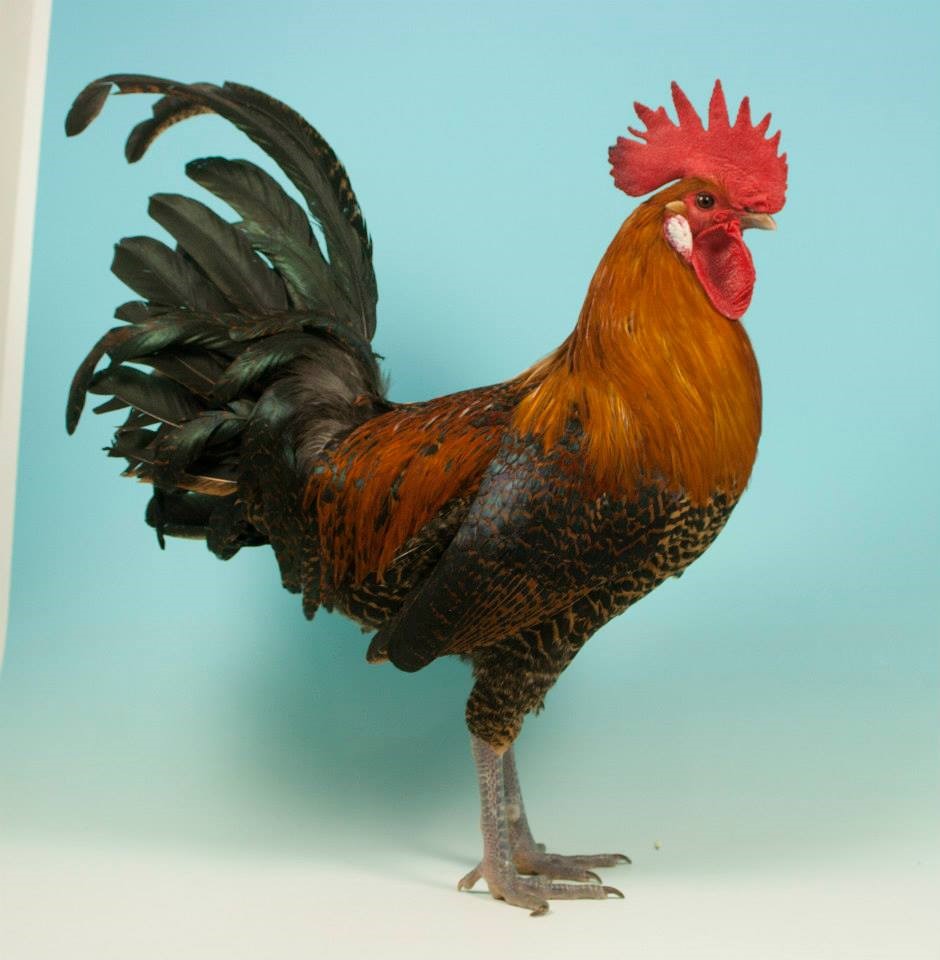Brakel is a village near the market town of Aalst/Alost, north-west of Brussels in Belgium. The Brakel fowl was once kept on almost every farm and smallholding in its home area, and was generally more important in Belgium than the neighboring breed, the Campine, which became better known in other countries. There is still an active Brakel Club in Belgium. Brakel males, which have normal cock feathering, are easily distinguished from the hen-feathered Campine males. The females of both breeds are very similar, but Brakel hens are heavier and stockier.
General characteristics: male
Carriage: Alert and graceful.
Type: Body proportionately long and deep, back moderately long, wide at the shoulders, narrowing to base of the tail, sloping slightly from shoulders to tail. Breast full, wide, deep, well rounded, carried well forward but not beyond a line drawn perpendicular to tip of beak. Wings moderately long and large, carried high, well above lower thighs, tips concealed by saddle feathers and ending short of stern. Main tail feathers broad, long, carried well back at an angle of 45 degrees and well spread, sickles broad, long and well curved, lesser sickles, coverts and saddle hackles long and abundant.
Head: Medium size, broad and deep. Beak medium length, slightly curved. Comb single, upright, of medium size evenly serrated, the back carried well out just clear of the neck, slightly coarse in texture. Eyes full, round and bright. Face smooth and free from wrinkles. Earlobes medium sized, oval shaped and smooth. Wattles medium size, well rounded, free from wrinkles or folds.
Neck: Moderately long, gracefully arched and well covered with hackle feathers.
Legs and feet: Moderately long shanks, round and free from feathers. Toes, four, medium length and well spread.
Female
With the exception of the single comb which falls gracefully over one side of the face, the general characteristics are similar to those of the male allowing for the natural sexual differences.
BANTAM
Brakel bantams should follow exactly the standard for the large fowl.
General characteristics: male
Carriage: Alert and graceful.
Type: Body proportionately long and deep, back moderately long, wide at the shoulders, narrowing to base of the tail, sloping slightly from shoulders to tail. Breast full, wide, deep, well rounded, carried well forward but not beyond a line drawn perpendicular to tip of beak. Wings moderately long and large, carried high, well above lower thighs, tips concealed by saddle feathers and ending short of stern. Main tail feathers broad, long, carried well back at an angle of 45 degrees and well spread, sickles broad, long and well curved, lesser sickles, coverts and saddle hackles long and abundant.
Head: Medium size, broad and deep. Beak medium length, slightly curved. Comb single, upright, of medium size evenly serrated, the back carried well out just clear of the neck, slightly coarse in texture. Eyes full, round and bright. Face smooth and free from wrinkles. Earlobes medium sized, oval shaped and smooth. Wattles medium size, well rounded, free from wrinkles or folds.
Neck: Moderately long, gracefully arched and well covered with hackle feathers.
Legs and feet: Moderately long shanks, round and free from feathers. Toes, four, medium length and well spread.
Female
With the exception of the single comb which falls gracefully over one side of the face, the general characteristics are similar to those of the male allowing for the natural sexual differences.
BANTAM
Brakel bantams should follow exactly the standard for the large fowl.
Please contact the breed registrar for more information - [email protected]


